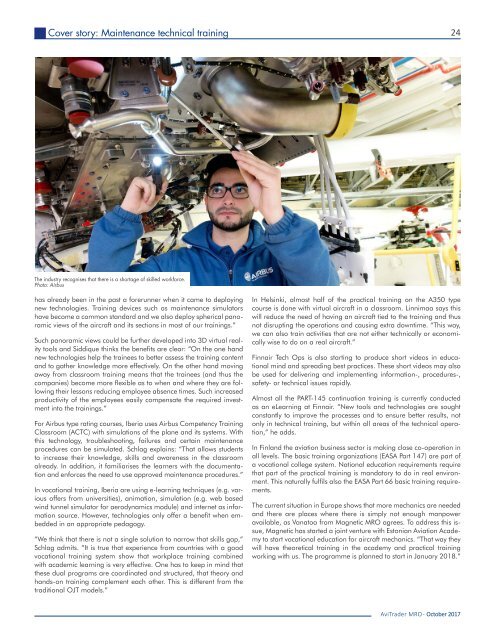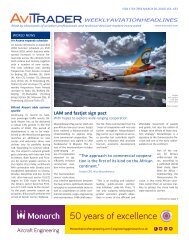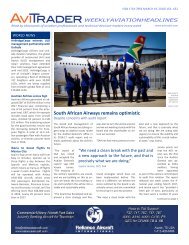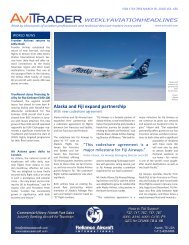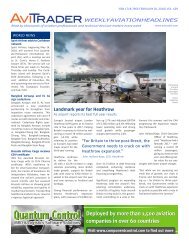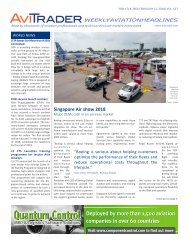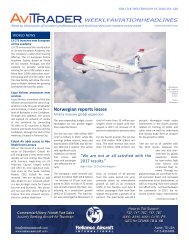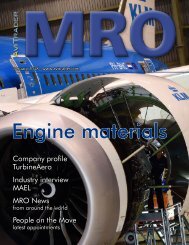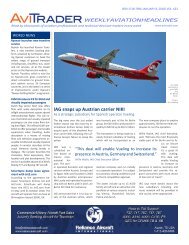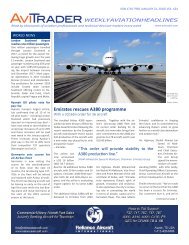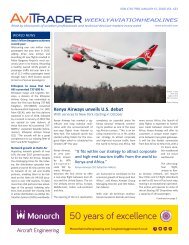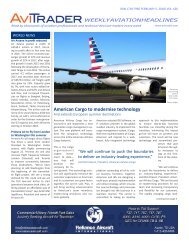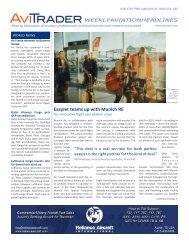AviTrader_Monthly_MRO_e-Magazine_2017-10
AviTrader_Monthly_MRO_e-Magazine_2017-10
AviTrader_Monthly_MRO_e-Magazine_2017-10
You also want an ePaper? Increase the reach of your titles
YUMPU automatically turns print PDFs into web optimized ePapers that Google loves.
Cover story: Maintenance technical training<br />
24<br />
The industry recognises that there is a shortage of skilled workforce.<br />
Photo: Airbus<br />
has already been in the past a forerunner when it came to deploying<br />
new technologies. Training devices such as maintenance simulators<br />
have become a common standard and we also deploy spherical panoramic<br />
views of the aircraft and its sections in most of our trainings.”<br />
Such panoramic views could be further developed into 3D virtual reality<br />
tools and Siddique thinks the benefits are clear: “On the one hand<br />
new technologies help the trainees to better assess the training content<br />
and to gather knowledge more effectively. On the other hand moving<br />
away from classroom training means that the trainees (and thus the<br />
companies) become more flexible as to when and where they are following<br />
their lessons reducing employee absence times. Such increased<br />
productivity of the employees easily compensate the required investment<br />
into the trainings.”<br />
For Airbus type rating courses, Iberia uses Airbus Competency Training<br />
Classroom (ACTC) with simulations of the plane and its systems. With<br />
this technology, troubleshooting, failures and certain maintenance<br />
procedures can be simulated. Schlag explains: “That allows students<br />
to increase their knowledge, skills and awareness in the classroom<br />
already. In addition, it familiarises the learners with the documentation<br />
and enforces the need to use approved maintenance procedures.”<br />
In vocational training, Iberia are using e-learning techniques (e.g. various<br />
offers from universities), animation, simulation (e.g. web based<br />
wind tunnel simulator for aerodynamics module) and internet as information<br />
source. However, technologies only offer a benefit when embedded<br />
in an appropriate pedagogy.<br />
“We think that there is not a single solution to narrow that skills gap,”<br />
Schlag admits. “It is true that experience from countries with a good<br />
vocational training system show that workplace training combined<br />
with academic learning is very effective. One has to keep in mind that<br />
these dual programs are coordinated and structured, that theory and<br />
hands-on training complement each other. This is different from the<br />
traditional OJT models.”<br />
In Helsinki, almost half of the practical training on the A350 type<br />
course is done with virtual aircraft in a classroom. Linnimaa says this<br />
will reduce the need of having an aircraft tied to the training and thus<br />
not disrupting the operations and causing extra downtime. “This way,<br />
we can also train activities that are not either technically or economically<br />
wise to do on a real aircraft.”<br />
Finnair Tech Ops is also starting to produce short videos in educational<br />
mind and spreading best practices. These short videos may also<br />
be used for delivering and implementing information-, procedures-,<br />
safety- or technical issues rapidly.<br />
Almost all the PART-145 continuation training is currently conducted<br />
as an eLearning at Finnair. “New tools and technologies are sought<br />
constantly to improve the processes and to ensure better results, not<br />
only in technical training, but within all areas of the technical operation,”<br />
he adds.<br />
In Finland the aviation business sector is making close co-operation in<br />
all levels. The basic training organizations (EASA Part 147) are part of<br />
a vocational college system. National education requirements require<br />
that part of the practical training is mandatory to do in real environment.<br />
This naturally fulfils also the EASA Part 66 basic training requirements.<br />
The current situation in Europe shows that more mechanics are needed<br />
and there are places where there is simply not enough manpower<br />
available, as Vanatoa from Magnetic <strong>MRO</strong> agrees. To address this issue,<br />
Magnetic has started a joint venture with Estonian Aviation Academy<br />
to start vocational education for aircraft mechanics. “That way they<br />
will have theoretical training in the academy and practical training<br />
working with us. The programme is planned to start in January 2018.”<br />
<strong>AviTrader</strong> <strong>MRO</strong> - October <strong>2017</strong>


